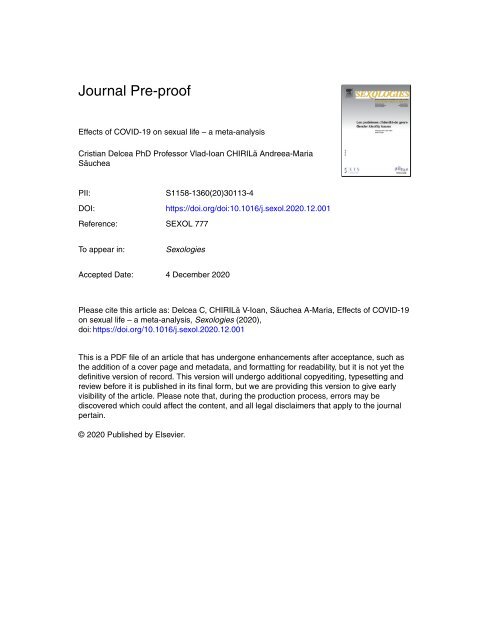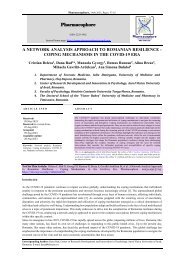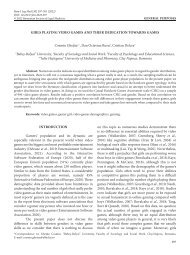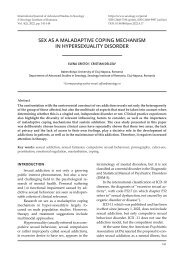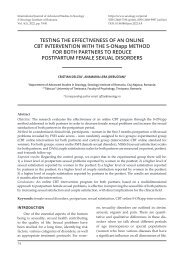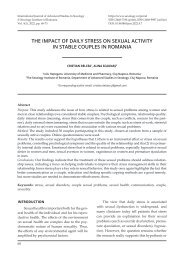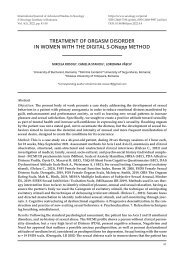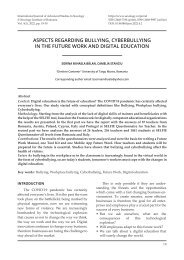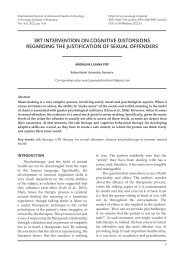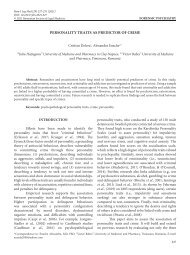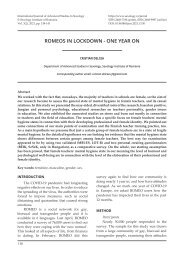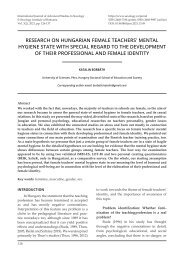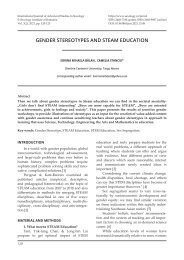Effects of COVID-19 on sexual life – a meta-analysis
Context Starting with the end of 2019, humanity is fighting a new type of virus, SARS-COV-2, which has brought great changes in people’s lives. The COVID-19 pandemic began at the end of 2019 and spread rapidly around the world, affecting the entire planet population. Methods In order to identify the studies on the topic for this meta-analysis, we performed an exclusively electronic search in the international databases for specialized literature: Google Scholar and ProQuest and other sources of specialty literature; and as a result of these searches, based on keywords, we found a number of 64 articles. The key words for this search were: pandemic, COVID-19, sexual life, sexual behavior, satisfaction, marital status, Coronavirus disease. Are represented by major conditions that stand at the basis of sexual disorders and of the sexual quality life during the COVID-19 period.
Context Starting with the end of 2019, humanity is fighting a new type of virus, SARS-COV-2, which has brought great changes in people’s lives. The COVID-19 pandemic began at the end of 2019 and spread rapidly around the world, affecting the entire planet population.
Methods In order to identify the studies on the topic for this meta-analysis, we performed an exclusively electronic search in the international databases for specialized literature: Google Scholar and ProQuest and other sources of specialty literature; and as a result of these searches, based on keywords, we found a number of 64 articles. The key words for this search were: pandemic, COVID-19, sexual life, sexual behavior, satisfaction, marital status, Coronavirus disease. Are represented by major conditions that stand at the basis of sexual disorders and of the sexual quality life during the COVID-19 period.
You also want an ePaper? Increase the reach of your titles
YUMPU automatically turns print PDFs into web optimized ePapers that Google loves.
Journal Pre-pro<str<strong>on</strong>g>of</str<strong>on</strong>g><br />
<str<strong>on</strong>g>Effects</str<strong>on</strong>g> <str<strong>on</strong>g>of</str<strong>on</strong>g> <str<strong>on</strong>g>COVID</str<strong>on</strong>g>-<str<strong>on</strong>g>19</str<strong>on</strong>g> <strong>on</strong> <strong>sexual</strong> <strong>life</strong> <strong>–</strong> a <strong>meta</strong>-<strong>analysis</strong><br />
Cristian Delcea PhD Pr<str<strong>on</strong>g>of</str<strong>on</strong>g>essor Vlad-Ioan CHIRILă Andreea-Maria<br />
Săuchea<br />
PII:<br />
S1158-1360(20)30113-4<br />
DOI:<br />
https://doi.org/doi:10.1016/j.sexol.2020.12.001<br />
Reference: SEXOL 777<br />
To appear in:<br />
Sexologies<br />
Accepted Date: 4 December 2020<br />
Please cite this article as: Delcea C, CHIRILă V-Ioan, Săuchea A-Maria, <str<strong>on</strong>g>Effects</str<strong>on</strong>g> <str<strong>on</strong>g>of</str<strong>on</strong>g> <str<strong>on</strong>g>COVID</str<strong>on</strong>g>-<str<strong>on</strong>g>19</str<strong>on</strong>g><br />
<strong>on</strong> <strong>sexual</strong> <strong>life</strong> <strong>–</strong> a <strong>meta</strong>-<strong>analysis</strong>, Sexologies (2020),<br />
doi: https://doi.org/10.1016/j.sexol.2020.12.001<br />
This is a PDF file <str<strong>on</strong>g>of</str<strong>on</strong>g> an article that has underg<strong>on</strong>e enhancements after acceptance, such as<br />
the additi<strong>on</strong> <str<strong>on</strong>g>of</str<strong>on</strong>g> a cover page and <strong>meta</strong>data, and formatting for readability, but it is not yet the<br />
definitive versi<strong>on</strong> <str<strong>on</strong>g>of</str<strong>on</strong>g> record. This versi<strong>on</strong> will undergo additi<strong>on</strong>al copyediting, typesetting and<br />
review before it is published in its final form, but we are providing this versi<strong>on</strong> to give early<br />
visibility <str<strong>on</strong>g>of</str<strong>on</strong>g> the article. Please note that, during the producti<strong>on</strong> process, errors may be<br />
discovered which could affect the c<strong>on</strong>tent, and all legal disclaimers that apply to the journal<br />
pertain.<br />
© 2020 Published by Elsevier.
<str<strong>on</strong>g>Effects</str<strong>on</strong>g> <str<strong>on</strong>g>of</str<strong>on</strong>g> <str<strong>on</strong>g>COVID</str<strong>on</strong>g>-<str<strong>on</strong>g>19</str<strong>on</strong>g> <strong>on</strong> <strong>sexual</strong> <strong>life</strong> - <strong>meta</strong>-<strong>analysis</strong><br />
Les effets du <str<strong>on</strong>g>COVID</str<strong>on</strong>g>-<str<strong>on</strong>g>19</str<strong>on</strong>g> sur la vie sexuelle <strong>–</strong> une méta-analyse<br />
Title: <str<strong>on</strong>g>Effects</str<strong>on</strong>g> <str<strong>on</strong>g>of</str<strong>on</strong>g> <str<strong>on</strong>g>COVID</str<strong>on</strong>g>-<str<strong>on</strong>g>19</str<strong>on</strong>g> <strong>on</strong> <strong>sexual</strong> <strong>life</strong> <strong>–</strong> a <strong>meta</strong>-<strong>analysis</strong><br />
Authors<br />
Author 1. Pr<str<strong>on</strong>g>of</str<strong>on</strong>g>essor Cristian DELCEA PhD<br />
`Iuliu Hațieganu` University <str<strong>on</strong>g>of</str<strong>on</strong>g> Medicine and Pharmacy. The street<br />
Victor Babes, no. 8, Cluj-Napoca Transylvania, 400000.<br />
Tel./Fax 0364-437140, email cristian.delcea.cj@gmail.com<br />
Author 2. Vlad-Ioan CHIRILĂ<br />
`Institute <str<strong>on</strong>g>of</str<strong>on</strong>g> Sexology` <str<strong>on</strong>g>of</str<strong>on</strong>g> Transylvania. The street Plevnei, no. 160,<br />
Cluj-Napoca, Transylvania, 400394.<br />
Tel./Fax 0364-437140, email vlad.i.chirila@gmail.com<br />
Journal Pre-pro<str<strong>on</strong>g>of</str<strong>on</strong>g><br />
Author 3. Andreea-Maria SĂUCHEA<br />
`Institute <str<strong>on</strong>g>of</str<strong>on</strong>g> Sexology` <str<strong>on</strong>g>of</str<strong>on</strong>g> Transylvania. The street Plevnei, no. 160,<br />
Cluj-Napoca, Transylvania, 400394.<br />
Tel./Fax 0364-437140, email andreeas96@gmail.com<br />
Page 1 <str<strong>on</strong>g>of</str<strong>on</strong>g> 10
C<strong>on</strong>flict <str<strong>on</strong>g>of</str<strong>on</strong>g> Interest: “N<strong>on</strong>e”<br />
Acknowledgement: Only if applicable<br />
Abstract<br />
C<strong>on</strong>text Starting with the end <str<strong>on</strong>g>of</str<strong>on</strong>g> 20<str<strong>on</strong>g>19</str<strong>on</strong>g>, humanity is fighting a new type <str<strong>on</strong>g>of</str<strong>on</strong>g> virus, SARS-COV-2,<br />
which has brought great changes in people’s lives. The <str<strong>on</strong>g>COVID</str<strong>on</strong>g>-<str<strong>on</strong>g>19</str<strong>on</strong>g> pandemic began at the end <str<strong>on</strong>g>of</str<strong>on</strong>g><br />
20<str<strong>on</strong>g>19</str<strong>on</strong>g> and spread rapidly around the world, affecting the entire planet populati<strong>on</strong>.<br />
Methods In order to identify the studies <strong>on</strong> the topic for this <strong>meta</strong>-<strong>analysis</strong>, we performed an<br />
exclusively electr<strong>on</strong>ic search in the internati<strong>on</strong>al databases for specialized literature: Google<br />
Scholar and ProQuest and other sources <str<strong>on</strong>g>of</str<strong>on</strong>g> specialty literature; and as a result <str<strong>on</strong>g>of</str<strong>on</strong>g> these searches,<br />
based <strong>on</strong> keywords, we found a number <str<strong>on</strong>g>of</str<strong>on</strong>g> 64 articles. The key words for this search were:<br />
pandemic, <str<strong>on</strong>g>COVID</str<strong>on</strong>g>-<str<strong>on</strong>g>19</str<strong>on</strong>g>, <strong>sexual</strong> <strong>life</strong>, <strong>sexual</strong> behavior, satisfacti<strong>on</strong>, marital status, Cor<strong>on</strong>avirus<br />
disease. Are represented by major c<strong>on</strong>diti<strong>on</strong>s that stand at the basis <str<strong>on</strong>g>of</str<strong>on</strong>g> <strong>sexual</strong> disorders and <str<strong>on</strong>g>of</str<strong>on</strong>g> the<br />
<strong>sexual</strong> quality <strong>life</strong> during the <str<strong>on</strong>g>COVID</str<strong>on</strong>g>-<str<strong>on</strong>g>19</str<strong>on</strong>g> period.<br />
Results Of the 64 articles resulting from the database search, 7 met the criteria for inclusi<strong>on</strong> in<br />
the study. Of the remaining 7 studies, 3 were c<strong>on</strong>ducted in the United States, <strong>on</strong>e in China, <strong>on</strong>e in<br />
Turkey, <strong>on</strong>e in Italy and <strong>on</strong>e in the United Kingdom <str<strong>on</strong>g>of</str<strong>on</strong>g> Great Britain and Northern Ireland. Most<br />
studies were c<strong>on</strong>ducted between March and April 2020 including a total <str<strong>on</strong>g>of</str<strong>on</strong>g> 6929 participants.<br />
C<strong>on</strong>clusi<strong>on</strong> The results showed there was a decrease in <strong>sexual</strong> activity during the period<br />
included in the <strong>analysis</strong>, which indicates the impact <strong>on</strong> the quality <str<strong>on</strong>g>of</str<strong>on</strong>g> sex <strong>life</strong> in individuals.<br />
Keywords: Covid-<str<strong>on</strong>g>19</str<strong>on</strong>g>, <strong>sexual</strong> act, <strong>sexual</strong> behavior, studies, articles.<br />
Résumé<br />
C<strong>on</strong>texte: Depuis la fin de l’année 20<str<strong>on</strong>g>19</str<strong>on</strong>g>, l’humanité lutte c<strong>on</strong>tre un nouveau virus, SARS-COV-<br />
2, qui a engendré des changements importants dans la vie des gens. La pandémie <str<strong>on</strong>g>COVID</str<strong>on</strong>g>-<str<strong>on</strong>g>19</str<strong>on</strong>g> a<br />
débuté fin 20<str<strong>on</strong>g>19</str<strong>on</strong>g> et s’est répandue rapidement dans le m<strong>on</strong>de entier, touchant la populati<strong>on</strong> entière<br />
de la planète.<br />
Méthodes : Afin d’identifier les études sur ce sujet pour cette méta-analyse, nous av<strong>on</strong>s fait une<br />
recherche exclusivement électr<strong>on</strong>ique dans les bases de d<strong>on</strong>nées internati<strong>on</strong>ales: Google Scholar<br />
et ProQuest et d’autres sources de littérature de spécialité; suite à ces recherches, en partant de<br />
mots clés, nous av<strong>on</strong>s trouvé 64 articles. Les mots clés <strong>on</strong>t été les suivants : pandémie, <str<strong>on</strong>g>COVID</str<strong>on</strong>g>-<br />
<str<strong>on</strong>g>19</str<strong>on</strong>g>, vie sexuelle, comportement sexuel, satisfacti<strong>on</strong>, état civil, maladie Cor<strong>on</strong>avirus. Nous av<strong>on</strong>s<br />
mis en avant également les affecti<strong>on</strong>s majeures qui s<strong>on</strong>t à l’origine des troubles sexuels et qui<br />
influencent la qualité de la vie sexuelle durant la période du <str<strong>on</strong>g>COVID</str<strong>on</strong>g>-<str<strong>on</strong>g>19</str<strong>on</strong>g>.<br />
Résultats : Des 64 articles trouvés dans les bases de d<strong>on</strong>nées, 7 <strong>on</strong>t rempli les critères pour être<br />
pris en c<strong>on</strong>sidérati<strong>on</strong> pour l’étude. Des 7, 3 <strong>on</strong>t été publiés aux Etas-Unis, un en Chine, un en<br />
Journal Pre-pro<str<strong>on</strong>g>of</str<strong>on</strong>g><br />
Page 2 <str<strong>on</strong>g>of</str<strong>on</strong>g> 10
Turquie, un en Italie et un au Royaume Uni et en Irlande du Nord. La plupart des études <strong>on</strong>t été<br />
réalisées pendant la période mars-avril 2020, comportant 6929 participannts.<br />
C<strong>on</strong>clusi<strong>on</strong> : Les analyses <strong>on</strong>t mis en évidence une diminuti<strong>on</strong> de l’activité sexuelle pendant la<br />
période c<strong>on</strong>cernée par cette analyse, ce qui a un impact majeur sur la qualité de la vie sexuelle<br />
chez les individus.<br />
Mots clés : Covid-<str<strong>on</strong>g>19</str<strong>on</strong>g>, acte sexuel, comportement, études, articles<br />
Introducti<strong>on</strong><br />
Since the end <str<strong>on</strong>g>of</str<strong>on</strong>g> 20<str<strong>on</strong>g>19</str<strong>on</strong>g>, humanity has been facing a new type <str<strong>on</strong>g>of</str<strong>on</strong>g> virus, SARS-COV-2, which<br />
has greatly affected all people’s lives. The <str<strong>on</strong>g>COVID</str<strong>on</strong>g>-<str<strong>on</strong>g>19</str<strong>on</strong>g> pandemic began in late 20<str<strong>on</strong>g>19</str<strong>on</strong>g> and spread<br />
rapidly around the world, affecting the entire populati<strong>on</strong> <str<strong>on</strong>g>of</str<strong>on</strong>g> the planet, being first documented in<br />
China, in December 20<str<strong>on</strong>g>19</str<strong>on</strong>g> according to World Health Organizati<strong>on</strong> ([WHO] 2020, “WHO<br />
announces <str<strong>on</strong>g>COVID</str<strong>on</strong>g>-<str<strong>on</strong>g>19</str<strong>on</strong>g> outbreak a pandemic”). On the 12 th <str<strong>on</strong>g>of</str<strong>on</strong>g> August 2020, 20 412 501 cases<br />
were reported globally (Johns Hopkins Center for Systems Science and Engineering, 2020).<br />
Since the CODIV-<str<strong>on</strong>g>19</str<strong>on</strong>g> pandemic has become a part <str<strong>on</strong>g>of</str<strong>on</strong>g> everyday <strong>life</strong>, researchers have begun to<br />
investigate how people’s lives are affected by the virus. Given the purpose <str<strong>on</strong>g>of</str<strong>on</strong>g> this research, we<br />
focused <strong>on</strong> studies that have impacted people’s sex lives and how this type <str<strong>on</strong>g>of</str<strong>on</strong>g> virus has altered or<br />
not their sex lives.<br />
Given the growing interest in this topic and the growing number <str<strong>on</strong>g>of</str<strong>on</strong>g> publicati<strong>on</strong>s, we decided<br />
to c<strong>on</strong>duct a <strong>meta</strong>-<strong>analysis</strong> to find out how the <str<strong>on</strong>g>COVID</str<strong>on</strong>g>-<str<strong>on</strong>g>19</str<strong>on</strong>g> pandemic affected / and still affects<br />
people’s sex <strong>life</strong> and <strong>sexual</strong> behavior. Taking into c<strong>on</strong>siderati<strong>on</strong> the growing number <str<strong>on</strong>g>of</str<strong>on</strong>g> cases, it<br />
is essential to find answers to how this pandemic affects people’s sex lives, so that soluti<strong>on</strong>s to<br />
these issues can be found in the future. The more similarities are observed between studies, the<br />
greater the chances are to finding answers to this issue. The <strong>analysis</strong> <str<strong>on</strong>g>of</str<strong>on</strong>g> different existing studies<br />
is <strong>on</strong>e <str<strong>on</strong>g>of</str<strong>on</strong>g> interest because this will be useful when answers to questi<strong>on</strong>s such as: “Does the<br />
<str<strong>on</strong>g>COVID</str<strong>on</strong>g>-<str<strong>on</strong>g>19</str<strong>on</strong>g> pandemic affect people’s <strong>sexual</strong> lives?" “What are the factors that affect sex <strong>life</strong>?”<br />
etc. are demanded.<br />
Since its discovery, the <str<strong>on</strong>g>COVID</str<strong>on</strong>g>-<str<strong>on</strong>g>19</str<strong>on</strong>g> virus has been epidemiologically associated with the<br />
Huanan Seafood Wholesale Market, where fish and wild animals are sold at a local level (Huang<br />
C et al, 2020). Subsequent evidence <str<strong>on</strong>g>of</str<strong>on</strong>g> this clinical infecti<strong>on</strong> suggests that SARS-CoV-2 is<br />
transmitted from pers<strong>on</strong> to pers<strong>on</strong> (Wang R et al, 2020). Massive alveolar damage and<br />
progressive respiratory failure can lead to severe death, and the number <str<strong>on</strong>g>of</str<strong>on</strong>g> lymphocytes,<br />
m<strong>on</strong>ocytes, leukocytes, biomarkers related to infecti<strong>on</strong>, inflammatory cytokines and T cells are<br />
also altered in patients with severe c<strong>on</strong>diti<strong>on</strong>s (WHO 2020, “Cor<strong>on</strong>avirus”, WHO 2020,<br />
“Defining <strong>sexual</strong> health”). According to the World Health Organizati<strong>on</strong>, the most comm<strong>on</strong><br />
symptoms <str<strong>on</strong>g>of</str<strong>on</strong>g> <str<strong>on</strong>g>COVID</str<strong>on</strong>g>-<str<strong>on</strong>g>19</str<strong>on</strong>g> are: fever, dry cough, fatigue, and some <str<strong>on</strong>g>of</str<strong>on</strong>g> the most comm<strong>on</strong> symptoms<br />
include: sore throat, diarrhea, c<strong>on</strong>junctivitis, headache, loss <str<strong>on</strong>g>of</str<strong>on</strong>g> taste or odor, rash <strong>on</strong> the skin or<br />
discolorati<strong>on</strong> <str<strong>on</strong>g>of</str<strong>on</strong>g> the fingers or toes; the most serious symptoms that require immediate attenti<strong>on</strong><br />
being shortness <str<strong>on</strong>g>of</str<strong>on</strong>g> breath and difficulty breathing, chest pain or pressure, loss <str<strong>on</strong>g>of</str<strong>on</strong>g> speech and<br />
movement (Jacob et al. 2020).<br />
Sexual <strong>life</strong>, <strong>sexual</strong>ity encompasses a multitude <str<strong>on</strong>g>of</str<strong>on</strong>g> phenomena which include partnerships,<br />
behaviors, attitudes, identity, orientati<strong>on</strong>, beliefs and activities (Li, W. et al, 2020) and<br />
specifically the <strong>sexual</strong> activity can include a multitude <str<strong>on</strong>g>of</str<strong>on</strong>g> acts, including the penetrative sex<br />
(vaginal, anal), oral sex and mutual masturbati<strong>on</strong>. Moreover, a safe and frequent sex <strong>life</strong> is<br />
Journal Pre-pro<str<strong>on</strong>g>of</str<strong>on</strong>g><br />
Page 3 <str<strong>on</strong>g>of</str<strong>on</strong>g> 10
associated with a multitude <str<strong>on</strong>g>of</str<strong>on</strong>g> benefits for both physical and mental health (Hensel et al, 2020),<br />
thus the current c<strong>on</strong>text and especially the period in which people were quarantined (in<br />
lockdown) is <str<strong>on</strong>g>of</str<strong>on</strong>g> interest in the study <str<strong>on</strong>g>of</str<strong>on</strong>g> people’s sex lives.<br />
The main purpose <str<strong>on</strong>g>of</str<strong>on</strong>g> this research is to analyze existing studies, to find out how the <str<strong>on</strong>g>COVID</str<strong>on</strong>g>-<br />
<str<strong>on</strong>g>19</str<strong>on</strong>g> pandemic affected people’s sex <strong>life</strong> and their <strong>sexual</strong> behavior. At the time <str<strong>on</strong>g>of</str<strong>on</strong>g> writing this<br />
study, any other <strong>meta</strong>-<strong>analysis</strong> studies were found to investigate this issue.<br />
Method<br />
Literature review<br />
An exclusively electr<strong>on</strong>ic search was performed to discover articles published until the<br />
3 rd <str<strong>on</strong>g>of</str<strong>on</strong>g> July 2020 without a specific starting point. The identified studies were searched in the<br />
databases <str<strong>on</strong>g>of</str<strong>on</strong>g> ProQuest and Google Scholar. The key words for the search were: pandemic,<br />
<str<strong>on</strong>g>COVID</str<strong>on</strong>g>-<str<strong>on</strong>g>19</str<strong>on</strong>g>, <strong>sexual</strong> <strong>life</strong>, <strong>sexual</strong> behavior, satisfacti<strong>on</strong>, marital status, Cor<strong>on</strong>avirus disease.<br />
Inclusi<strong>on</strong>/ exclusi<strong>on</strong> criteria<br />
The initial search resulted in 64 articles, and the first criteri<strong>on</strong> for these to be included in<br />
the research was for the studies to be quantitative and published in English. The other criteria for<br />
inclusi<strong>on</strong> in the study were: (1) <strong>sexual</strong> behavior to be clearly defined; (2) to investigate the<br />
relati<strong>on</strong>ship between the <str<strong>on</strong>g>COVID</str<strong>on</strong>g>-<str<strong>on</strong>g>19</str<strong>on</strong>g> pandemic and <strong>sexual</strong> intercourse; (3) the <str<strong>on</strong>g>COVID</str<strong>on</strong>g>-<str<strong>on</strong>g>19</str<strong>on</strong>g><br />
pandemic to be clearly defined; (4) to investigate the effects <str<strong>on</strong>g>of</str<strong>on</strong>g> <str<strong>on</strong>g>COVID</str<strong>on</strong>g>-<str<strong>on</strong>g>19</str<strong>on</strong>g> <strong>on</strong> <strong>sexual</strong> <strong>life</strong>; (5)<br />
sufficient data exist so the size <str<strong>on</strong>g>of</str<strong>on</strong>g> the effect can be calculated. Based <strong>on</strong> the inclusi<strong>on</strong> / exclusi<strong>on</strong><br />
criteria, a number <str<strong>on</strong>g>of</str<strong>on</strong>g> 7 articles were included in this research.<br />
Articles identified through database search<br />
(n=64)<br />
Abstracts screened<br />
(n=64)<br />
Journal Pre-pro<str<strong>on</strong>g>of</str<strong>on</strong>g><br />
Records exluded (duplicated)<br />
(n = 3)<br />
Full text assed for<br />
eligibilty (n=14)<br />
Full text articles excluded<br />
for not meeting the<br />
inclusi<strong>on</strong> crietria<br />
(n=7)<br />
Studies included<br />
(n=7)<br />
Page 4 <str<strong>on</strong>g>of</str<strong>on</strong>g> 10
Figure 1. Number <str<strong>on</strong>g>of</str<strong>on</strong>g> articles included in the study<br />
Instruments used:<br />
Cocci- the data was collected through <strong>on</strong> <strong>on</strong>line survey, taking a close look at <strong>sexual</strong> behavior<br />
before and after pandemic. Beck Depressi<strong>on</strong> Inventory and Beck Anxiety Inventory were also<br />
used in this body <str<strong>on</strong>g>of</str<strong>on</strong>g> research, the scales were validated <strong>on</strong> Italian populati<strong>on</strong>.<br />
Hensel- c<strong>on</strong>sists 26 questi<strong>on</strong>s that measure <strong>sexual</strong> behaviors, available in Spanish and English.<br />
Jacob- <strong>on</strong>line survey that has questi<strong>on</strong>s regarding <strong>sexual</strong> behavior, demographic details and<br />
health status<br />
McKey-<strong>on</strong>line survey that has questi<strong>on</strong>s from Stanford study <str<strong>on</strong>g>of</str<strong>on</strong>g> Americans’ c<strong>on</strong>cerns about<br />
<str<strong>on</strong>g>COVID</str<strong>on</strong>g>-<str<strong>on</strong>g>19</str<strong>on</strong>g>, symptoms and individual behavioral changes, <strong>sexual</strong> behavior measures from the<br />
last 30 days, changes in <strong>sexual</strong> behavior due to <str<strong>on</strong>g>COVID</str<strong>on</strong>g>-<str<strong>on</strong>g>19</str<strong>on</strong>g>, the use <str<strong>on</strong>g>of</str<strong>on</strong>g> dating apps<br />
Sanchez- this questi<strong>on</strong>naire measures the impact that <str<strong>on</strong>g>COVID</str<strong>on</strong>g>-<str<strong>on</strong>g>19</str<strong>on</strong>g> has had in the following areas:<br />
general wellbeing, <strong>sexual</strong> and substance use behavior, HIV and STI preventi<strong>on</strong>, HIV treatment;<br />
Weiran Li- this questi<strong>on</strong>naire has 12 items that measure demographic characteristics and <strong>sexual</strong><br />
behavior from the past and present.<br />
Yuksel- this instrument for a Female Sexual Functi<strong>on</strong> Index (Cr<strong>on</strong>bachs Alpha= 0.92, test-retest<br />
reliability coefficients 0.79-0.86), detailed questi<strong>on</strong>s about medical history and demographic<br />
characteristics.<br />
The studies included in the <strong>meta</strong>-<strong>analysis</strong> measured covariables, for example Cocci at al.,<br />
measured covariables such as anxiety and depressi<strong>on</strong>. Hensel et al., measured the number <str<strong>on</strong>g>of</str<strong>on</strong>g><br />
children that the participants had, depressi<strong>on</strong> symptoms, and perceived l<strong>on</strong>eliness in the last<br />
m<strong>on</strong>th, behavior and knowledge about <str<strong>on</strong>g>COVID</str<strong>on</strong>g>-<str<strong>on</strong>g>19</str<strong>on</strong>g>. Jacob et all, measured covariables such as<br />
health status.<br />
McKay et al., measured covariables such as the use <str<strong>on</strong>g>of</str<strong>on</strong>g> dating websites and applicati<strong>on</strong>s in<br />
order to find a new <strong>sexual</strong> partner. Sanchez et al., measured covariables such as general health<br />
status, use <str<strong>on</strong>g>of</str<strong>on</strong>g> substance, HIV treatment. Weiran Li et al, the covariables were <strong>sexual</strong> orientati<strong>on</strong>,<br />
medical history, <strong>sexual</strong>ly transmitted disease status. Yuksel et al., measured covariables such as<br />
health status.<br />
Journal Pre-pro<str<strong>on</strong>g>of</str<strong>on</strong>g><br />
For the <strong>analysis</strong> <str<strong>on</strong>g>of</str<strong>on</strong>g> data obtained, the Comprehensive Meta Analysis was used. We chose to<br />
analyze the data using the “odds ratio” to be able to observe how many times did the <strong>sexual</strong><br />
activity <str<strong>on</strong>g>of</str<strong>on</strong>g> the populati<strong>on</strong> change. An “odds ratio” less than 1, indicates a decrease in targeted<br />
activities for the observed group. An odds ratio <str<strong>on</strong>g>of</str<strong>on</strong>g> 1 indicates that there is no change between the<br />
two groups, as the probability <str<strong>on</strong>g>of</str<strong>on</strong>g> engaging in <strong>sexual</strong> relati<strong>on</strong>s is the same as before the pandemic.<br />
While, an odds ratio bigger than 1, indicates that people have more <strong>sexual</strong> activity than before.<br />
Page 5 <str<strong>on</strong>g>of</str<strong>on</strong>g> 10
Table 1. Summary <str<strong>on</strong>g>of</str<strong>on</strong>g> studies included in the <strong>meta</strong>-<strong>analysis</strong><br />
Study Country Study type Study<br />
format<br />
Period No. <str<strong>on</strong>g>of</str<strong>on</strong>g><br />
participants<br />
Cocci,<br />
2020<br />
Italy Quantitative survey NS 1515<br />
Quantitative<br />
Hensel,<br />
2020<br />
Jacob,<br />
2020<br />
McKay,<br />
2020<br />
Sanchez,<br />
2020<br />
Yuksel,<br />
2020<br />
Weiran<br />
Li, 2020<br />
USA<br />
UK<br />
USA<br />
USA<br />
Turkey<br />
China<br />
Results<br />
Quantitative<br />
Quantitative<br />
Quantitative<br />
Quantitative<br />
Quantitative<br />
survey<br />
survey<br />
survey<br />
survey<br />
observatio<br />
nal study -<br />
mixed<br />
survey<br />
April<br />
10-20<br />
March<br />
17-26<br />
April 10<br />
to May<br />
10<br />
April 2-<br />
13<br />
March<br />
11 -<br />
April 12<br />
March<br />
13-15<br />
1010<br />
868<br />
<str<strong>on</strong>g>19</str<strong>on</strong>g>68<br />
1051<br />
58 26.6<br />
459<br />
Medium %F Marital<br />
age<br />
status<br />
21 NS NS<br />
34.4 51.5 66.1% -<br />
married<br />
33.9% -<br />
not<br />
married<br />
NS 63.1 55.3% -<br />
married<br />
44.7% -<br />
single<br />
44.6 NS 54.2% <strong>–</strong><br />
married<br />
45.8% <strong>–</strong><br />
not<br />
married<br />
35 0 NS<br />
Journal Pre-pro<str<strong>on</strong>g>of</str<strong>on</strong>g><br />
100 100% -<br />
married<br />
NS 41.17 53% -<br />
married<br />
47% -<br />
not<br />
married<br />
The database search resulted in 64 articles, <str<strong>on</strong>g>of</str<strong>on</strong>g> which <strong>on</strong>ly 7 met the inclusi<strong>on</strong> criteria. The<br />
countries where the studies were c<strong>on</strong>ducted are the United States <str<strong>on</strong>g>of</str<strong>on</strong>g> America, 3 studies, the<br />
United Kingdom, <strong>on</strong>e study, Italy, <strong>on</strong>e study, China, <strong>on</strong>e study and Turkey, <strong>on</strong>e study. Most <str<strong>on</strong>g>of</str<strong>on</strong>g><br />
the studies were <str<strong>on</strong>g>of</str<strong>on</strong>g> the survey type, given the c<strong>on</strong>text <str<strong>on</strong>g>of</str<strong>on</strong>g> the pandemic and the limitati<strong>on</strong>s it<br />
exerts <strong>on</strong> researchers. The 7 studies included a number <str<strong>on</strong>g>of</str<strong>on</strong>g> 6929 participants, the average age <str<strong>on</strong>g>of</str<strong>on</strong>g><br />
the studies reaching a minimum <str<strong>on</strong>g>of</str<strong>on</strong>g> 21 years and a maximum <str<strong>on</strong>g>of</str<strong>on</strong>g> 44.6. The populati<strong>on</strong>s <strong>on</strong> which<br />
the studies were c<strong>on</strong>ducted were bel<strong>on</strong>ging both to the LGBTQ community and people with a<br />
hetero<strong>sexual</strong> orientati<strong>on</strong>.<br />
We used the random model to calculate the “Odds ratio”, because the Q probability is<br />
estimated at 0.05, and the value <str<strong>on</strong>g>of</str<strong>on</strong>g> I 2 is 98,508. The two indicators point to the fact that there is<br />
some heterogeneity in our data, which can be given by the populati<strong>on</strong> <strong>sexual</strong> orientati<strong>on</strong>, by<br />
cultural differences and repopulati<strong>on</strong>s, but also by age differences and social expectati<strong>on</strong>s<br />
relevant to each age. As it can be seen in Table 2, the odds ratio in this case is 0.227 (95% CI<br />
Sexual<br />
orientati<strong>on</strong><br />
NS<br />
straight<br />
straight<br />
LGBTQ +<br />
bi<strong>sexual</strong><br />
LGBTQ<br />
just<br />
females<br />
straight<br />
Page 6 <str<strong>on</strong>g>of</str<strong>on</strong>g> 10
[0.097-0.796], p = 0.017), which means that, before the pandemic, there is a probability <str<strong>on</strong>g>of</str<strong>on</strong>g><br />
approximately 4.4 times more involvement in <strong>sexual</strong> behavior than during the pandemic.<br />
Table 2. “odds ratio” for the <strong>sexual</strong> activity during the pandemic<br />
period<br />
When testing for the publicati<strong>on</strong> bias, as it can be observed in figure 2, the “odds ratio”<br />
remains unchanged, which means that there is no publicati<strong>on</strong> bias. A total <str<strong>on</strong>g>of</str<strong>on</strong>g> 546 studies should<br />
not have been published for the p value to become greater than the alpha value <str<strong>on</strong>g>of</str<strong>on</strong>g> 0.05. The “trim<br />
and fill” <strong>analysis</strong> also supports the absence <str<strong>on</strong>g>of</str<strong>on</strong>g> a publicati<strong>on</strong> bias, indicating that there is no need<br />
to aband<strong>on</strong> or add a study to achieve symmetry.<br />
Journal Pre-pro<str<strong>on</strong>g>of</str<strong>on</strong>g><br />
Figure 2. “Funnel plot” for the <strong>sexual</strong> activity during the pandemic period<br />
Another variable c<strong>on</strong>sidered to be important in understanding <strong>sexual</strong> activity during the<br />
pandemic is desire, and the “odds ratio” from Table 3 for <strong>sexual</strong> desire during the pandemic<br />
indicates that that <strong>sexual</strong> desire is likely to be smaller during the pandemic, even if this<br />
difference in probabilities is not statistically significant.<br />
Page 7 <str<strong>on</strong>g>of</str<strong>on</strong>g> 10
Table 3. “Odds ratio” for the <strong>sexual</strong> desire during the pandemic period<br />
Discussi<strong>on</strong><br />
The purpose <str<strong>on</strong>g>of</str<strong>on</strong>g> this <strong>meta</strong>-<strong>analysis</strong> was to analyze existing research and provide an answer<br />
to the questi<strong>on</strong> “Has the <str<strong>on</strong>g>COVID</str<strong>on</strong>g>-<str<strong>on</strong>g>19</str<strong>on</strong>g> pandemic affected peoples sex lives?” as noted in the results<br />
secti<strong>on</strong>, from the data <strong>analysis</strong>, <strong>sexual</strong> activity was reduced with a frequency <str<strong>on</strong>g>of</str<strong>on</strong>g> 4.4 times during<br />
the pandemic in comparis<strong>on</strong> to the period before. This decrease can be caused by the major<br />
change that took place during this period but also by the danger perceived by people; it is<br />
possible that after this anxiety, caused by <str<strong>on</strong>g>COVID</str<strong>on</strong>g>-<str<strong>on</strong>g>19</str<strong>on</strong>g>, <strong>sexual</strong> activity will return to normal. As<br />
we all know, humans have innate capabilities to preserve their own <strong>life</strong>, which are str<strong>on</strong>ger that<br />
the desire to reproduce, so the death anxiety felt by the populati<strong>on</strong> right now might be held<br />
accountable for decreasing the desire to be <strong>sexual</strong>ly intimate with others. Also, the limitati<strong>on</strong>s<br />
imposed by the government had influenced the level <str<strong>on</strong>g>of</str<strong>on</strong>g> depressi<strong>on</strong> in the general populati<strong>on</strong><br />
which by its own definiti<strong>on</strong> translates into lower <strong>sexual</strong> desire. What is certain is that the changes<br />
we have been subjected to, led to a decrease in <strong>sexual</strong> activity.<br />
When analyzing <strong>sexual</strong> desire (Table 3) we observed that before the pandemic there was<br />
a 2.5 higher probability <str<strong>on</strong>g>of</str<strong>on</strong>g> <strong>sexual</strong> desire, but from a statistical point <str<strong>on</strong>g>of</str<strong>on</strong>g> view this result is not<br />
significant.<br />
Regarding the theoretical and practical implicati<strong>on</strong>s <str<strong>on</strong>g>of</str<strong>on</strong>g> this study, the results show a<br />
decreasing trend in <strong>sexual</strong> activity, which needs to be further analyzed if an interventi<strong>on</strong>, will be<br />
needed to increase <strong>sexual</strong> activity.<br />
Given the complexity <str<strong>on</strong>g>of</str<strong>on</strong>g> the situati<strong>on</strong> and the large number <str<strong>on</strong>g>of</str<strong>on</strong>g> areas in which the <str<strong>on</strong>g>COVID</str<strong>on</strong>g>-<br />
<str<strong>on</strong>g>19</str<strong>on</strong>g> pandemic left its mark, it is necessary to study as many aspects as possible and provide<br />
answers to as many issues as possible. Although the main focus <str<strong>on</strong>g>of</str<strong>on</strong>g> most research at the moment<br />
is finding a treatment for the virus, it is important to study how people have adapted to this<br />
situati<strong>on</strong>. We have tried to see how this pandemic left its mark <strong>on</strong> the quality <str<strong>on</strong>g>of</str<strong>on</strong>g> human lives, and<br />
some <str<strong>on</strong>g>of</str<strong>on</strong>g> the impediments encountered are a result <str<strong>on</strong>g>of</str<strong>on</strong>g> the low number <str<strong>on</strong>g>of</str<strong>on</strong>g> publicati<strong>on</strong>s in this field,<br />
but also to the fact that, at the time <str<strong>on</strong>g>of</str<strong>on</strong>g> this research, the <str<strong>on</strong>g>COVID</str<strong>on</strong>g>-<str<strong>on</strong>g>19</str<strong>on</strong>g> pandemic was rampant (Rus<br />
M. et al, 2020).<br />
Therefore, pre-post-pandemic <strong>analysis</strong> <str<strong>on</strong>g>of</str<strong>on</strong>g> the impact <str<strong>on</strong>g>of</str<strong>on</strong>g> this challenging period <strong>on</strong> human<br />
<strong>sexual</strong> <strong>life</strong> was not possible, but <strong>on</strong>ly <strong>on</strong>e applied to the period before the pandemic; subsequent<br />
research, post-pandemic, could perform such an <strong>analysis</strong>. Although as many groups as possible<br />
were included in this <strong>analysis</strong>, we d<strong>on</strong>’t have informati<strong>on</strong> <strong>on</strong> how people, with psychological and<br />
psychological vulnerabilities, have reacted to the measures imposed by this pandemic.<br />
Another impediment faced during this research was the narrow period <str<strong>on</strong>g>of</str<strong>on</strong>g> time that<br />
allowed us to select studies from the period January-May 2020.<br />
Future research <strong>on</strong> this topic could include more studies, to select studies over a l<strong>on</strong>ger<br />
period <str<strong>on</strong>g>of</str<strong>on</strong>g> time, and at the same time a repetiti<strong>on</strong> <str<strong>on</strong>g>of</str<strong>on</strong>g> this <strong>analysis</strong>, after the <str<strong>on</strong>g>COVID</str<strong>on</strong>g>-<str<strong>on</strong>g>19</str<strong>on</strong>g> pandemic,<br />
would be preferable.<br />
Journal Pre-pro<str<strong>on</strong>g>of</str<strong>on</strong>g><br />
Page 8 <str<strong>on</strong>g>of</str<strong>on</strong>g> 10
C<strong>on</strong>clusi<strong>on</strong><br />
The present research aimed to verify if the <str<strong>on</strong>g>COVID</str<strong>on</strong>g>-<str<strong>on</strong>g>19</str<strong>on</strong>g> pandemic affected people’s <strong>sexual</strong> lives.<br />
In terms <str<strong>on</strong>g>of</str<strong>on</strong>g> results, a decrease in <strong>sexual</strong> activity was observed, which indicates the impairment <str<strong>on</strong>g>of</str<strong>on</strong>g><br />
the individuals’ quality <str<strong>on</strong>g>of</str<strong>on</strong>g> <strong>sexual</strong> <strong>life</strong>. Thus, <strong>on</strong>e can c<strong>on</strong>clude that before the pandemic, the<br />
probability <str<strong>on</strong>g>of</str<strong>on</strong>g> people engaging in <strong>sexual</strong> activity was higher than during the pandemic, seen as<br />
the period when this <strong>analysis</strong> was made.<br />
References<br />
Cocci, A., Giunti, D., T<strong>on</strong>i<strong>on</strong>i, C. et al. Love at the time <str<strong>on</strong>g>of</str<strong>on</strong>g> the Covid-<str<strong>on</strong>g>19</str<strong>on</strong>g> pandemic: preliminary<br />
results <str<strong>on</strong>g>of</str<strong>on</strong>g> an <strong>on</strong>line survey c<strong>on</strong>ducted during the quarantine in Italy. Int J Impot Res (2020).<br />
https://doi.org/10.1038/s41443-020-0305-x<br />
Hensel, D. J., Rosenberg, M., Luetke, M., Fu, T. C., & Herbenick, D. (2020). Changes in Solo<br />
and Partnered Sexual Behaviors during the <str<strong>on</strong>g>COVID</str<strong>on</strong>g>-<str<strong>on</strong>g>19</str<strong>on</strong>g> Pandemic: Findings from a US<br />
Probability Survey. medRxiv.<br />
Huang C, Wang Y, Li X, et al. Clinical features <str<strong>on</strong>g>of</str<strong>on</strong>g> patients infected with 20<str<strong>on</strong>g>19</str<strong>on</strong>g> novel Cor<strong>on</strong>avirus<br />
in Wuhan, China. Lancet. 2020; 395(10223):497-506.<br />
Jacob, Louis & Smith, Lee & Butler, Laurie & Barnett, Yv<strong>on</strong>ne & Grabovac, Igor & Mcdermott,<br />
Daragh & Armstr<strong>on</strong>g, Nicola & Yakundi, Annita & Tully, Mark. (2020). Challenges in the<br />
Practice <str<strong>on</strong>g>of</str<strong>on</strong>g> Sexual Medicine in the Time <str<strong>on</strong>g>of</str<strong>on</strong>g> <str<strong>on</strong>g>COVID</str<strong>on</strong>g>-<str<strong>on</strong>g>19</str<strong>on</strong>g> in the United Kingdom. Journal <str<strong>on</strong>g>of</str<strong>on</strong>g><br />
Sexual Medicine. 10.1016/j.jsxm.2020.05.001.<br />
Johns Hopkins Center for Systems Science and Engineering. Cor<strong>on</strong>avirus <str<strong>on</strong>g>COVID</str<strong>on</strong>g>-<str<strong>on</strong>g>19</str<strong>on</strong>g> Global<br />
Cases. 2020 https://cor<strong>on</strong>avirus.jhu.edu/map.html. Accessed in 08 August 2020.<br />
Li, W., Li, G., Xin, C., Wang, Y., & Yang, S. (2020). Changes in <strong>sexual</strong> behaviors <str<strong>on</strong>g>of</str<strong>on</strong>g> young<br />
women and men during the Cor<strong>on</strong>avirus disease 20<str<strong>on</strong>g>19</str<strong>on</strong>g> outbreak: a c<strong>on</strong>venience sample from the<br />
epidemic area. The Journal <str<strong>on</strong>g>of</str<strong>on</strong>g> Sexual Medicine.<br />
McKay, T., Henne, J., G<strong>on</strong>zales, G., Quarles, R., Gavulic, K. A., & Garcia Gallegos, S. (2020).<br />
The <str<strong>on</strong>g>COVID</str<strong>on</strong>g>-<str<strong>on</strong>g>19</str<strong>on</strong>g> Pandemic and Sexual Behavior am<strong>on</strong>g Gay and Bi<strong>sexual</strong> Men in the United<br />
States. Available at SSRN 3614113.<br />
Rus M., Sandu L. M., Tănase T., Boumediene S., Delcea C., (2020). The effect <str<strong>on</strong>g>of</str<strong>on</strong>g> the cor<strong>on</strong>a<br />
virus (<str<strong>on</strong>g>COVID</str<strong>on</strong>g>-<str<strong>on</strong>g>19</str<strong>on</strong>g>) <strong>on</strong> Mental Health. Int J Advanced Studies in Sexology. Vol. 2, Issue 2, pp.<br />
116-120. Sexology Institute <str<strong>on</strong>g>of</str<strong>on</strong>g> Romania. DOI: 10.46388/ijass.2020.13.30.<br />
Journal Pre-pro<str<strong>on</strong>g>of</str<strong>on</strong>g><br />
Sanchez, T. H., Zlotorzynska, M., Rai, M., & Baral, S. D. (2020). Characterizing the Impact <str<strong>on</strong>g>of</str<strong>on</strong>g><br />
<str<strong>on</strong>g>COVID</str<strong>on</strong>g>-<str<strong>on</strong>g>19</str<strong>on</strong>g> <strong>on</strong> men, who have sex with men across the United States in April, 2020. AIDS and<br />
Behavior, 1-9.<br />
Wang R, Zhang X, Irwin DM, Shen Y. Emergence <str<strong>on</strong>g>of</str<strong>on</strong>g> SARS-like Cor<strong>on</strong>avirus poses new<br />
challenge in China. J Infect. 2020; 80(3): 350-371<br />
World Health Organizati<strong>on</strong>. Cor<strong>on</strong>avirus. Accesed at 15 July, 2020. Available at:<br />
https://www.who.int/health-topics/cor<strong>on</strong>avirus#tab=tab_3<br />
Page 9 <str<strong>on</strong>g>of</str<strong>on</strong>g> 10
World Health Organizati<strong>on</strong>. Defining <strong>sexual</strong> health 2020. Accessed August 12, 2020.Available<br />
at:https://www.who.int/reproductivehealth/topics/<strong>sexual</strong>_health/sh_definiti<strong>on</strong>s/en/<br />
World Health Organizati<strong>on</strong>. WHO announces <str<strong>on</strong>g>COVID</str<strong>on</strong>g>-<str<strong>on</strong>g>19</str<strong>on</strong>g> outbreak a pandemic. 2020. Accessed<br />
July 15, 2020. Available at: https://www.euro.who.int/en/health-topics/healthemergencies/cor<strong>on</strong>avirus-covid-<str<strong>on</strong>g>19</str<strong>on</strong>g>/news/news/2020/3/who-announces-covid-<str<strong>on</strong>g>19</str<strong>on</strong>g>-outbreak-apandemic,<br />
Yuksel, B., & Ozgor, F. (2020). Effect <str<strong>on</strong>g>of</str<strong>on</strong>g> the <str<strong>on</strong>g>COVID</str<strong>on</strong>g>‐ <str<strong>on</strong>g>19</str<strong>on</strong>g> pandemic <strong>on</strong> female <strong>sexual</strong><br />
behavior. Internati<strong>on</strong>al Journal <str<strong>on</strong>g>of</str<strong>on</strong>g> Gynecology & Obstetrics. https://doi.org/10.1002/ijgo.13<str<strong>on</strong>g>19</str<strong>on</strong>g>3<br />
Journal Pre-pro<str<strong>on</strong>g>of</str<strong>on</strong>g><br />
Page 10 <str<strong>on</strong>g>of</str<strong>on</strong>g> 10


